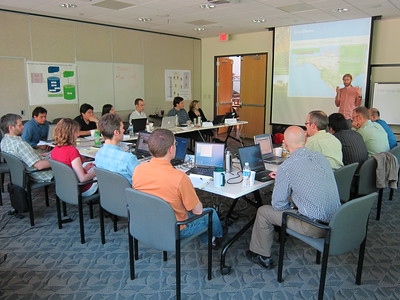Lately I've been reading a lot of science papers related to protected areas and 30x30: the idea of protecting (and/or 'conserving') 30% of the earth by 2030. I thought it might be helpful to share all of the summaries I have on the topic in one place. As always, these summaries are my personal opinion only, and I welcome input / critique / etc.
Specific to
recommendations for 30 x 30 in the US:
Simmons et
al. 2021 (a non-peer-reviewed white paper) looks at a few options to meet 30 by
30 in the U.S. (protecting 30% of the country on land by 2030) with four
different focal objectives (all also minimizing acquisition cost): area alone,
carbon sequestration and avoided emissions, landscape connectivity, and
climate-resilient species and habitat. It’s a fairly coarse and simplistic
assessment, but it does a good job highlighting the kinds of tradeoffs to
consider when deciding which lands we advocate for protecting. Check out Figure
2 which shows how their four scenarios perform (on cost, ecosystem
representation, and climate mitigation) and where they would protect across the
lower 48 states. They close with recommending clear objectives to prioritize where
to protect, focus protections on threatened areas, develop metrics to track
progress and impact (including on issues like social equity), and use diverse
options (beyond traditional protected areas) to provide protection. Check out
the appendix for maps showing which areas are already somewhat protected (as
GAP 3).
Jenkins et
al. 2015 highlights an inconvenient truth about protected areas in the United
States: they are mostly located in places with relatively low species richness
and threats of conversion. In other words, if the main goal of protected areas
is to prevent as many species as possible from going extent, they're poorly
sited. You can compare biodiversity maps in Fig 1 & 2 to PAs in Fig 3 to
see the mismatch. Fig 4 has their recommendations for 9 areas where
conservation should be focused in the SE and West coast.
Other
papers on protection targets etc.:
Barnes et
al. 2018 highlights
the downside of area targets: they may drive siting protected areas (PAs) in
bad places and poor enforcement / management. They promote a shift to
outcome-based protected area targets (meaning the targets are about
biodiversity gains or avoided losses), emphasizing representation and
connectivity, and building the evidence base for which factors affect how well
PAs deliver conservation outcomes.
Bhola et
al. 2020 sums up four different philosophies or perspectives for setting global
conservation goals. 1) extending Aichi biodiversity target #11 (protecting
& managing 17% of land and inland water, plus 10% coastal and marine, while
considering biodiversity, equity, ecosystem services, and connectivity) to 2030
and ensuring the qualitative piece is achieved. 2) Big area-based goals like
'half earth' or protecting 30% of the earth by 2030 (still ensuring that the right
places get protected). 3) ‘New conservation’ (broadening the tent for
conservation via ecosystem services, ecotourism, and the private sector). 4)
‘Whole earth’ conservation which attacks root causes of habitat loss like
inequality and economic growth (while arguing against separating people from
nature). It's a quick read but start w/ Table 1 for a summary of the four
perspectives, and Figure 1 which shows how the choice of goal (in this case,
biodiversity vs. ecosystem service production) affects which areas you’d want
to protect.
Devillers et al. 2015 argues that marine protected areas
(MPAs) have largely been cited in remote areas with low threats that the MPAs
are intended to address. They point out that politics drive MPAs to be
established in places that minimize costs and conflicts with commercial
interests, but that MPAs that avoid potential conflicts will by definition have
low impact relative to business as usual. They offer two Australian case
studies and in particular highlight how well the 2004 rezoning of the great
barrier reef was done in terms of improving ecological representation, although
still with room to improve. They suggest planners of MPAs and/or no-take zones
ask four questions: 1. Are MPAs intended to protect biodiversity? 2. Do
proposed MPAs give precedence to more threatened biodiversity features? 3. Do
MPAs adequately represent all biodiversity features of interest? and 4. Do MPAs
adequately represent variation within features (like bioregions) to
focus on the most threatened sub-areas?
Hannah et
al. 2020 estimates that effectively conserving 30% of tropical land could cut
predicted species extinction by ~1/2-2/3 (if the conserved areas are both cited
ideally and managed well: this is not about legal protection alone). Conserving
50% could reduce extinction by more like 2/3-80% (see Table 1 for details
including how this varies by region). This is useful to understand how
effective conservation can be at different scales. But it's important to note
that citing PAs in ideal locations continues to be elusive, this model relies
on fairly simple assumptions using species-area curves, and the fact that the
results didn't vary much with climate change (RCP2.6 vs RCP 8.5) is concerning.
Nonetheless, this could be motivating to highlight the importance of protecting
and managing enough of the right places on earth to slow species extinction.
Jantke et
al. 2019 proposes a clever way to ensure that "% protected" goals
like 30 by 30 (protecting 30% of a country on land and water by 2030) don't
focus on easy to protect habitat types while other habitat types remain mostly
unprotected. They suggest reporting “mean target achievement” where the %
protected of each habitat type would be averaged and compared to a
habitat-level goal (See section 2.2 for the equation - crucially achievement
maxes out at 100% so overprotection in one habitat can't compensate for
underprotection in another). They use Australia's Commonwealth Marine Reserve
as an example; it protects 43% of the five marine regions it covers, but still
falls short of its goal of protecting at least 10% of each of the 53 bioregions
within it. This is a great complement to the total % protected indicator, as
ecological representation has badly lagged behind total protection, and the
rush to protect a lot more area very quickly will make it very tempting to
focus on the easiest habitats to protect even though many other habitats have
little to no protection.
Mogg et al. 2019 looks at how much protection is needed
to keep land mammals healthy. They assume every species needs 80% of its range
protected (plus 10% more as buffer), so Oceania and South America need more
than 70% of their land to be protected! They ignore any considerations about meeting
demand for food or livelihoods, and it’s odd to me to see the focus on making
protected areas much larger much faster given that the paper’s intro mentions
that enforcement of current PAs is a major problem. It’s definitely an
interesting analysis, but I think it’s really hard to try and get support
behind a proposal that doesn’t even attempt to consider human needs as well as
ecosystem / species needs.
Global
estimates of % protection hide the fact that protection varies widely for
different ecosystems and habitat types. Sayre et al. 2020 splits that up into
278 natural ecosystems (based on temperature, moisture, elevation, land cover,
etc.). If you limit protection to IUCN 1-4 (stricter protection), 9 of those
278 were totally unprotected and 206 were below 8.5% protected (halfway to
Aichi targets). If you use IUCN 1-6 (including areas allowing more human use)
only 1/3 of ecosystems are below 8.5%. Table 5 shows how much of each major
land cover group (forests, grasslands, etc.) has been lost, Table 4 has the
details for the 278 ecosystems. Some figures are easier to see online: https://www.sciencedirect.com/science/article/pii/S2351989419307231?via%3Dihub
Waldron et al. 2020 looks at global financial
implications of 30 x 30 (6 terrestrial and 5 marine scenarios), and for
tropical forests & mangroves adds in avoided costs and non-monetary
ecosystem service values. They estimate that expanding protected areas (PAs) to
30% could result in increased direct global revenues of $64-454 billion / yr
(depending on the scenario chosen, and mostly driven by increased nature
tourism, see Table 3) as well as more food and wood production. Broader
economic benefits (largely from avoided storm damage) could be $170-534 billion
/ yr more. With a estimated cost of $103-$178 billion / yr (which includes
funding to manage existing PAs), they find net economic benefits to 30x30
across all scenarios (spend some time with Table 3 to see the details, but $235
billion / yr is the lowest net financial benefit). It's hard to vet this kind
of complex analysis with a ton of assumptions. My gut tells me this is a pretty optimistic assessment due to several key assumptions (like a social cost of
carbon at $135-540 / t CO2e , assuming big tourism increases and scarcity of wood driving up forest product revenue, etc.). But they point out that it could be an underestimate
since they didn't include broader benefits of other ecosystems like grasslands. Thoughts
welcome! Note that other scientists criticized the Waldron paper, noting that
not nearly enough has been done to estimate how 30x30 would affect people (nor
to consult with them), among other issues. The critique (Agrawal et al. 2020)
is here: https://openlettertowaldronetal.wordpress.com/
Wenzel et al. 2020 (NOAA’s 2020 MPA report) has a good
overview of marine (and great lakes) protection in the U.S. 26% of US waters
are in an MPA, but only 3% in a no-take zone. Page 5 of the PDF has a breakdown
by region showing that some places like Alaska are disproportionately
unprotected. The report also indicates MPA coverage by habitat type (e.g. 83%
of mangroves are protected), calls for OECMs to improve MPA connectivity, and
notes the need for better management of MPAs.
REFERENCES:
Agrawal et
al. 2020. An Open Letter to the Lead Authors of ‘Protecting 30% of the Planet
for Nature: Costs, Benefits and Implications.’ https://openlettertowaldronetal.wordpress.com/
Barnes, M.
D., Glew, L., Wyborn, C., & Craigie, I. D. (2018). Prevent perverse
outcomes from global protected area policy. Nature Ecology & Evolution,
2(5), 759–762. https://doi.org/10.1038/s41559-018-0501-y
Bhola, N.,
Klimmek, H., Kingston, N., Burgess, N. D., Soesbergen, A., Corrigan, C.,
Harrison, J., & Kok, M. T. J. (2020). Perspectives on area‐based
conservation and its meaning for future biodiversity policy. Conservation
Biology, 00(0), cobi.13509. https://doi.org/10.1111/cobi.13509
Devillers,
R., Pressey, R. L., Grech, A., Kittinger, J. N., Edgar, G. J., Ward, T., &
Watson, R. (2015). Reinventing residual reserves in the sea: are we favouring
ease of establishment over need for protection? Aquatic Conservation: Marine
and Freshwater Ecosystems, 25(4), 480–504. https://doi.org/10.1002/aqc.2445
Hannah, L.,
Roehrdanz, P. R., Marquet, P. A., Enquist, B. J., Midgley, G., Foden, W.,
Lovett, J. C., Corlett, R. T., Corcoran, D., Butchart, S. H. M. M., Boyle, B.,
Feng, X., Maitner, B., Fajardo, J., McGill, B. J., Merow, C., Morueta-Holme,
N., Newman, E. A., Park, D. S., … Svenning, J. C. (2020). 30% Land Conservation
and Climate Action Reduces Tropical Extinction Risk By More Than 50%.
Ecography, 43(7), 943–953. https://doi.org/10.1111/ecog.05166
Jantke, K.,
Kuempel, C. D., McGowan, J., Chauvenet, A. L. M., & Possingham, H. P.
(2019). Metrics for evaluating representation target achievement in protected
area networks. Diversity and Distributions, 25(2), 170–175. https://doi.org/10.1111/ddi.12853
Jenkins, C.
N., Van Houtan, K. S., Pimm, S. L., & Sexton, J. O. (2015). US protected
lands mismatch biodiversity priorities. Proceedings of the National Academy of
Sciences, 112(16), 5081–5086. https://doi.org/10.1073/pnas.1418034112
Mogg, S.,
Fastre, C., Jung, M., & Visconti, P. (2019). Targeted expansion of
Protected Areas to maximise the persistence of terrestrial mammals. BioRxiv,
3056, 1–22. https://doi.org/10.1101/608992
Sayre, R.,
Karagulle, D., Frye, C., Boucher, T., Wolff, N. H., Breyer, S., Wright, D.,
Martin, M., Butler, K., Van Graafeiland, K., Touval, J., Sotomayor, L.,
McGowan, J., Game, E. T., & Possingham, H. (2020). An assessment of the
representation of ecosystems in global protected areas using new maps of World
Climate Regions and World Ecosystems. Global Ecology and Conservation,
21(December), e00860. https://doi.org/10.1016/j.gecco.2019.e00860
Simmons, B.
A., Nolte, C., & McGowan, J. (2021). Delivering on Biden’s 2030
Conservation Commitment. https://www.bu.edu/gdp/2021/01/28/delivering-on-bidens-2030-conservation-commitment/
Waldron,
A., Adams, V., Allan, J., Arnell, A., Asner, G., Atkinson, S., Baccini, A.,
Baillie, J. E., Balmford, A., Beau, J. A., Brander, L., Brondizio, E., Bruner,
A., Burgess, N., Burkart, K., Butchart, S., Wenzel, L., D’Iorio, M., Wahle, C.,
Cid, G., Canizzo, Z., & Darr, K. (2020). Marine protected areas 2020:
Building effective conservation networks. https://nmsmarineprotectedareas.blob.core.windows.net/marineprotectedareas-prod/media/docs/2020-mpa-building-effective-conservation-networks.pdf
Wenzel, L., D’Iorio, M., Wahle, C., Cid, G., Canizzo, Z., & Darr, K. (2020). Marine protected areas 2020: Building effective conservation networks. https://nmsmarineprotectedareas.blob.core.windows.net/marineprotectedareas-prod/media/docs/2020-mpa-building-effective-conservation-networks.pdf










